To expand your news reach, consider advertising with our media partner, Patch Media, at https://heypapipromotionsmedia.town.news/. Patch is a nationwide news network comprising over 1,000 hyperlocal websites dedicated to community news across the United States. For press release distribution services, please call or visit https://heypapipromotions.com/advertise.
🌏 Blogs / Articles / News / Classifieds / Press Releases / PSA / Podcast / Poetry / Storytelling
All Posts (7287)
Greetings in The Mighty Name of Jesus, The Christ!!!
Understanding
Brothers and Sisters there are and will be things that We do not Understand. We Ask, We Seek, We Knock and sometimes Jesus is Silent, with No Understanding to Why He does not Answer. Is it because we seem to Not have enough Faith, not even that of a Mustard Seed? Is there Sin in Our Lives that Prevents us from having Understanding? Is because Our Blessing is being held up because someone else is Disobedient in What they are supposed to do? Is it Satan or his Demons that fight against the Understanding? Is it Jesus who is Protecting Us from knowing an answer of Understanding because of the enemy? Is it because we do not Understand Jesus Timing in all events that will lead to His Glory? Is it that Understanding will not be given, because Jesus has another Plan then What we Understand? Is it that We are trying to Force Jesus to bring Understanding because of Our Flesh?
There are so many reasons Why We May Not Understand many things, but even in the Lack of Understanding let us Praise Jesus because He is Still Lord and Savior!!
There is one thing that We must Understand, that the Closer we have a Relationship With Jesus, the more We Walk in The Spirit, the harder things become on this earth. The Flesh will always Fight Against The Spirit, it will be a Constant Battle and in these Battles there can be many times of a Lack Of Understanding, but, we press on.
1 Corinthians 9:24-27 KJV
"24 Know ye not that they which run in a race run all, but one receiveth the prize? So run, that ye may obtain. 25 And every man that striveth for the mastery is temperate in all things. Now they [do it] to obtain a corruptible crown; but we an incorruptible. 26 I therefore so run, not as uncertainly; so fight I, not as one that beateth the air: 27 But I keep under my body, and bring [it] into subjection: lest that by any means, when I have preached to others, I myself should be a castaway."
Galatians 5:17 KJV
“For the flesh lusteth against the Spirit, and the Spirit against the flesh: and these are contrary the one to the other: so that ye cannot do the things that ye would."
Romans 6:15-16 KJV
"15 What then? shall we sin, because we are not under the law, but under grace? God forbid. 16 Know ye not, that to whom ye yield yourselves servants to obey, his servants ye are to whom ye obey; whether of sin unto death, or of obedience unto righteousness?"
My Brothers and Sisters let us Walk with an Understanding In The Spirit, bringing Our Flesh Under Control, to be Aware of Our Walk each and every hour! Let us be Lead by The Holy Spirit in all things rather we Have an Understanding or not, in The Spirit it does not matter!! Let The Holy Spirit Lead Us, The Church, into the Battles with victory over The Flesh that Jesus will Receive All The Praise and Glory!!!
All of the True Saints before us, Walked In The Spirit, being an Example of how we should Walk. In Hebrews it is written that many, many Walked In Faith, Having NO Understanding Of What They Pursued but did so even to the End Of Their Lives.
Hebrews 11:8 KJV
"By faith Abraham, when he was called to go out into a place which he should after receive for an inheritance, obeyed; and he went out, not knowing whither he went."
Hebrews 11:20-23 KJV
"20 By faith Isaac blessed Jacob and Esau concerning things to come. 21 By faith Jacob, when he was a dying, blessed both the sons of Joseph; and worshipped, [leaning] upon the top of his staff. 22 By faith Joseph, when he died, made mention of the departing of the children of Israel; and gave commandment concerning his bones. 23 By faith Moses, when he was born, was hid three months of his parents, because they saw [he was] a proper child; and they were not afraid of the king's commandment."
I know, some of you are thinking, “Wait a minute, you were talking about Understanding and now you are talking about Faith?”, yes, both Walk Hand In Hand together in the journey that we face. For does not The Scriptures say, that Faith is the Substance Hoped For, and the Evidence Not Seen! So then, Walking in Faith may have No Understanding to it’s Manifestation, but yet we Walk!!!
For example, consider Noah who took 120 years to build the Ark, seeing No Evidence of the Rain, but for the whole time was made fun of. Noah had No True Understanding to What The Father told him to do, but Noah Walked In Faith, that even though there was not a full Understanding, continued in His Journey!
Sometimes Brothers and Sisters we Pray, Believe but in many cases, we Pray, Believe not Understanding What we are Praying and Believing for! We sometimes think we Need this or that, not fully Understanding what it is we really need. Sometimes Jesus has to bring Understanding before we can ask, but then there are times we must ask without Understanding, which in doing so, exercises Our Faith!!!
Brothers and Sisters there are many of you who are steadfast proclaiming Prophesy of Jesus Return when you should be more concerned about are You Ready for His Return! You need to be more steadfast in getting Yourself In Order before Jesus comes. In Scripture were there not Ten Virgins, but only Five were Allowed In? Did not Jesus say, that just because You Call Me Lord means nothing, but only those who Do The Fathers Will? You Think you Understand the Prophecies, but you do not!!! too many of you are Looking at Daniel, Isaiah, Ezekiel and so forth, and Not Understanding what Jesus himself said the Season would be like…
Matthew 24:3-14 KJV
"3 And as he sat upon the mount of Olives, the disciples came unto him privately, saying, Tell us, when shall these things be? and what [shall be] the sign of thy coming, and of the end of the world? 4 And Jesus answered and said unto them, Take heed that no man deceive you. 5 For many shall come in my name, saying, I am Christ; and shall deceive many. 6 And ye shall hear of wars and rumours of wars: see that ye be not troubled: for all [these things] must come to pass, but the end is not yet. 7 For nation shall rise against nation, and kingdom against kingdom: and there shall be famines, and pestilences, and earthquakes, in divers places. 8 All these [are] the beginning of sorrows. 9 Then shall they deliver you up to be afflicted, and shall kill you: and ye shall be hated of all nations for my name's sake. 10 And then shall many be offended, and shall betray one another, and shall hate one another. 11 And many false prophets shall rise, and shall deceive many. 12 And because iniquity shall abound, the love of many shall wax cold. 13 But he that shall endure unto the end, the same shall be saved. 14 And this gospel of the kingdom shall be preached in all the world for a witness unto all nations; and then shall the end come."
These Scriptures that Jesus spoke of are What you should be concerned with, more so then any other. Jesus is Telling Us, The Church, The SEASON, NOT THE TIME of His Return. Many of these things have not happened yet, but too many of you are worried about the Temple being rebuilt!!! I do not See in the above Scriptures that Jesus was concerned about that, but was letting us know The Seasons that would happen. We know that in SOME Countries, this is happening, but what Jesus is speaking of will happen across the globe!!! Again, you, Church, have no Understanding of the above Scriptures and Chose to Ignore!!!
We need to be Walking In Faith Without Understanding the full picture. We, ourselves, need to be Studying The Scriptures on How To Live and Why To Live every day!! Does not The Scriptures tell us that we Should Examine Ourselves, What or Why must we do that? Is it not because Jesus has said that no matter how many times you Call Me Lord, I am not because You are Not Doing My Fathers Will!!!!
Matthew 7:21-23 KJV
"21 Not every one that saith unto me, Lord, Lord, shall enter into the kingdom of heaven; but he that doeth the will of my Father which is in heaven. 22 Many will say to me in that day, Lord, Lord, have we not prophesied in thy name? and in thy name have cast out devils? and in thy name done many wonderful works? 23 And then will I profess unto them, I never knew you: depart from me, ye that work iniquity."
You, Church, need to come to an Understanding of What Jesus is Talking About! Then Examine Yourselves accordingly. You think going to a church every Sunday or when ever the doors are open makes you Justified!! I Rebuke You!!! For going to a church is NOT going to Save You when Jesus Comes, how ignorant YOU ARE!!! If You do not Become the Living Word Of God, then YOU will NOT GO TO HEAVEN!!!
In Romans we are told that We MUST have Our Minds changed into the Will Of The Father and when Our Minds have been changed, then so will Our Ways be changed and we Gain an Understanding we did not have before!!!
Romans 12:1-2 KJV
"1 I beseech you therefore, brethren, by the mercies of God, that ye present your bodies a living sacrifice, holy, acceptable unto God, [which is] your reasonable service. 2 And be not conformed to this world: but be ye transformed by the renewing of your mind, that ye may prove what [is] that good, and acceptable, and perfect, will of God."
2 Corinthians 5:17 KJV
"Therefore if any man [be] in Christ, [he is] a new creature: old things are passed away; behold, all things are become new."
The only way 2 Corinthians 5:17 can come to pass is if Romans 12:1-2 happens first!!! When we Change our Minds to The Understanding Of Jesus, then, and only then, do the Things Of Old Pass Away and All Things Become New!!! Because what is written in Romans is unto The Flesh to changes Us to Walk In The Spirit as Corinthians says.
Understand Church, Salvation is not just Confessing Jesus as Savior, He MUST Become Lord by Us Being Transformed Into His Image!!!
2 Corinthians 13:5 KJV
“Examine yourselves, whether ye be in the faith; prove your own selves. Know ye not your own selves, how that Jesus Christ is in you, except ye be reprobates?"
Church do you Not Understand that it is By Our Choices rather We Change or Not into The Image Of Jesus? Some of you believe that Jesus Changed Your Flesh, this is Not So, but Your Spirit He did Renew. If Our Flesh were changed then why are there so many Scriptures to One Avenue Of Faith? Why is it that The Word says that WE MUST Bring Our Bodies INTO Subjection To What? The Spirit!!!
1 Corinthians 9:27 KJV
“But I keep under my body, and bring [it] into subjection: lest that by any means, when I have preached to others, I myself should be a castaway."
So then, there is Work to be done, that we Make Our Body’s Subject to The Spirit in All Ways and In All Things. Understand Church, it’s Not a Free Ride!, we Must be Changed from The Inside Out. The Word must be taken in as you would eat a meal when are really hungry, as the meal gives you Strength and Energy to those things that are needful to the flesh, so does Taking in The Word gives us Change and Strengthens us in The Spirit to do Spiritual Things that are needed.
Understand this Church, just Reading Your Bible every day, does NOT do the trick!!! You MUST take Action to that in which You Read. As James says, Faith without Works Is Dead, so as The Body without the Spirit is Dead! The Action is to have a Relationship With Jesus by Becoming as Jesus Is and the only way that can happen is by taking the Living Word of God and Ingesting it to Walk In and Through The Word by The Holy Spirit. It is Our Responsibility to be Transformed, The Holy Spirit will help us, but, WE have to Choose before Understanding is given to us!!!
Think on these thing very carefully, read this message several times, Understand By The Spirit!!!
Amen and Amen!!!
Email: godsonlyfoundation@gmail.com
Website: http://apostlelee.com/
The first epistle of John encourages the believers to stay connected to the Lord and live in obedience to His Word. John used a keyword multiple times to emphasize how we can accomplish those preceding instructions. Click on the link below to read what that word is. #1John #BibleStudy #Devotions #Relationship
In Psalm 41, King David prayed a prayer that focused on God's mercy and protection. He prayed it during a time when he was ill and felt betrayed. David laid out his complaints not at the Lord but before Him. Click on the link below to see how David ended his conversation. #BibleStudy #Devotions #Psalms #worship
Greetings in The Mighty Name of Jesus, The Christ!!!
Walk In Your Blessing
Matthew 21:21-22 KJV
"21 Jesus answered and said unto them, Verily I say unto you, If ye have faith, and doubt not, ye shall not only do this [which is done] to the fig tree, but also if ye shall say unto this mountain, Be thou removed, and be thou cast into the sea; it shall be done. 22 And all things, whatsoever ye shall ask in prayer, believing, ye shall receive."
Brothers and Sisters are You Walking In Your Blessing? It is one thing to Pray and say that You Believe, it is another thing to Walk In That Blessing! Many of you are down cast because You Did Not Truly Believe What You Prayed!!!
Now to Clarify before going any further, What You Pray must be according to The Father’s Will, His Plans for Your Life. If you Pray for a Million Dollars, chances are that no matter how much you Pray and Believe, it is NOT going to happen, Unless it deals with the Direct Plans For YOUR Life.
Matthew 7:21 KJV
“Not every one that saith unto me, Lord, Lord, shall enter into the kingdom of heaven; but he that doeth the will of my Father which is in heaven."
Now to explain in part The Fathers Will. Both The Father and The Son MUST Agree being in One Accord, which means that Jesus is not going to Give something that His Father is not okay with, no matter how many times you ask. There is also the reverse, The Father is Not going to Give What His Son Does Not Desire to Glorify His Name!!!
What many people still do not Understand is that The Old Testament is The Fathers doing, The New Testament is The Son’s doing, there was a Transferring of Power and Authority from The Father to The Son, but The Son, will not do anything against His Fathers Will. This means that anything that is Within The Father’s Will, The Son will Agree With You On. There were some changes on How God deals with His People, in the Old Testament mainly The Prophets kept order, in The New Testament it is now The Apostles, Prophets, Evangelist, Pastor and Teacher, these ARE the Ministering Authority to The Body, not Your Boards or of Laying Of Hands, these Offices can ONLY be given By Jesus!!!
1 Corinthians 12:18, 29-31 KJV
"18 But now hath God set the members every one of them in the body, as it hath pleased him. ... 29 [Are] all apostles? [are] all prophets? [are] all teachers? [are] all workers of miracles? 30 Have all the gifts of healing? do all speak with tongues? do all interpret? 31 But covet earnestly the best gifts: and yet shew I unto you a more excellent way."
The point of these Scriptures is to say Don’t Walk Where You Were Never Called To Walk!!! This Includes Prayer, Do Not Ask For Things That Will Not Glorify Jesus!!! Jesus is not going to Bless You with something that He Does Not Receive All The Glory For! Jesus Called me to be an Apostle, and not like men have determined, so, many, many of my Blessings Coordinate with My Calling, to Bear Witness to Jesus as Lord, in My Life and in My Calling as an Apostle!
James said that many of you Ask and do not Receive because YOU ask for something that is Not Going To Happen!
James 4:3, 5 KJV
"3 Ye ask, and receive not, because ye ask amiss, that ye may consume [it] upon your lusts. ... 5 Do ye think that the scripture saith in vain, The spirit that dwelleth in us lusteth to envy?"
James 1:6-8 KJV
"6 But let him ask in faith, nothing wavering. For he that wavereth is like a wave of the sea driven with the wind and tossed. 7 For let not that man think that he shall receive any thing of the Lord. 8 A double minded man [is] unstable in all his ways."
Jesus said, “And all things, whatsoever ye shall ask in prayer, believing, ye shall receive." The Believing part here is Walking In Your Blessing, that is, you start Thanking Jesus For The Answer Before You Have Received It!!! Jesus wants to Know that Your Faith Lies With Him and Not of Yourself or Anyone Else.
Hebrews 11:1-2 KJV
"1 Now faith is the substance of things hoped for, the evidence of things not seen. 2 For by it the elders obtained a good report."
Giving Jesus The Glory of Your Blessing puts everything into His Hands. Now another thing that You Must Understand, is that You can Thank Jesus for something and yet Have NO Faith!!! These people go out and do it themselves and then say Jesus gave it to them, when Jesus did not!!! In order to Walk In Your Blessing, you MUST First be Walking In The Spirit and Not Your Flesh. You may say, “Are not All Things given in the Flesh”, No they are not! When you Walk In The Spirit the Flesh becomes less important because you See Things through God’s Eyes and Not Your Own Eyes. Your Blessings that You Walk In will be to Glorify Jesus as Lord. As I have used the Centurion last week, here again another point to be made, The Centurion Called Jesus Lord, he Knew Who Jesus Was and He Believed Jesus As Lord and Savior!!! The Centurion Knew that all Jesus had to do was Speak and IT WAS DONE!!! But Understand this, the Centurion had NOT RECEIVED HIS BLESSING YET, BUT KNEW IT WAS COMING!!!
Matthew 8:5-10 KJV
"5 And when Jesus was entered into Capernaum, there came unto him a centurion, beseeching him, 6 And saying, Lord, my servant lieth at home sick of the palsy, grievously tormented. 7 And Jesus saith unto him, I will come and heal him. 8 The centurion answered and said, Lord, I am not worthy that thou shouldest come under my roof: but speak the word only, and my servant shall be healed. 9 For I am a man under authority, having soldiers under me: and I say to this [man], Go, and he goeth; and to another, Come, and he cometh; and to my servant, Do this, and he doeth [it]. 10 When Jesus heard [it], he marvelled, and said to them that followed, Verily I say unto you, I have not found so great faith, no, not in Israel."
Look at The Joy Our Lord Jesus had in this man, so much He Proclaimed Aloud to Israel, “I have not found so great faith, no, not in Israel”, Jesus was Excited that this Roman Centurion, an enemy to Israel, Believed In and Through Jesus that no matter what Jesus would Say or Do, IT WAS DONE!!! The Centurion Walked Out His Faith, knowing that when he would arrive at home, his servant would be healed. We have no idea how far the Centurion had to travel, but it does not matter, he had his answer before he ever left Jesus, we Must also Walk In Our Blessings the same!!
Thanking Jesus before hand is not Wishful Believing, it is that You Know that Your Blessings come from Jesus, WHY, because You Asked, Seek and Knocked in Faith and now You are Thanking Jesus for the End Results Before Seeing Them!!! Within the Task that you have been given, Jesus will Answer the Call, even more then you have asked for all because You Praised Him For The Blessing! So for now on, you are going to Pray, Trust, Praise, Receive!! This is Walking In Your Blessing!!!
Amen and Amen!!!
Email: godsonlyfoundation@gmail.com
Website: ApostleLee.com
The writer of Psalm 44 had quite a dilemma. He knew how God fought for the Israelites, but when he wrote that Psalm, he blamed God for coming against them. Have you ever felt like God was nowhere to be found or seemed to be working against you? Click on the link below to get the full story. #BibleStudy #Devotions #Psalms #worship
https://www.ramckinley.com/give-glory-to-god-for-his-unfailing-love/
What Is Moisture Wicking Polyester Fabric?
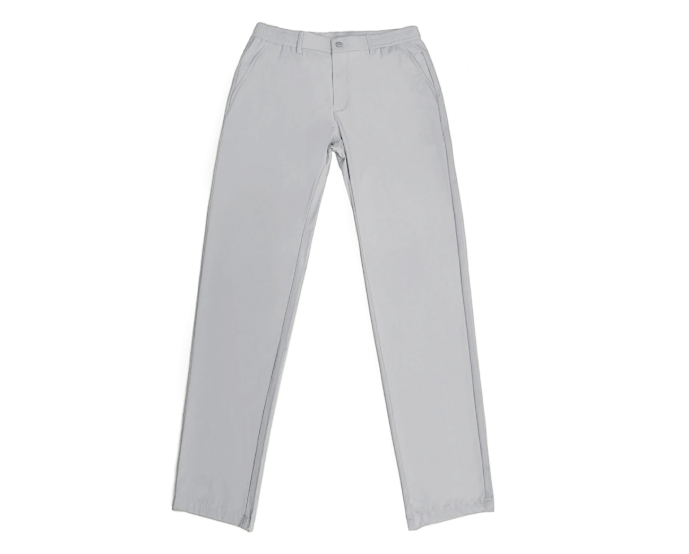
Why Consider Moisture Wicking Polyester Fabric for Men's Dress Pants?
- Sweat Management: Keeps you dry throughout the day.
- Breathability: Enhances airflow compared to traditional blends.
- Durability: Polyester holds up well against repeated washing and wear.
- Wrinkle Resistance: Ideal for maintaining a clean, polished look.
- Lightweight Feel: Comfortable even in warmer climates or active settings.
How Does Moisture Wicking Technology Work?
Is Moisture Wicking Polyester Fabric Breathable?
Does Moisture Wicking Polyester Fabric Feel Comfortable?
Are Moisture Wicking Polyester Dress Pants Formal Enough?
- Less creasing during travel
- Easier maintenance
- All-day freshness
- UV protection
How Does Moisture Wicking Polyester Fabric Perform in Hot or Humid Weather?
- Moving moisture away from the skin
- Drying quickly
- Maintaining shape despite sweat
- Preventing bacterial growth and odor
Is It Sustainable to Use Moisture Wicking Polyester Fabric?
What Are the Downsides of Moisture Wicking Polyester Fabric?
- Heat Retention: Poorly constructed versions may feel warm in extreme heat.
- Static Build-Up: Especially in dry conditions, though this can be managed with fabric treatments.
- Environmental Concerns: Virgin polyester is not biodegradable, highlighting the importance of choosing recycled options.
How to Care for Moisture Wicking Polyester Dress Pants?
- Machine wash cold: Avoid hot water to preserve the fibers.
- Use mild detergent: Harsh chemicals can degrade fabric treatments.
- Avoid fabric softeners: They can block the fabric’s capillaries and reduce wicking ability.
- Tumble dry low or air dry: Prevent shrinkage and heat damage.
Who Should Wear Moisture Wicking Dress Pants?
- Office professionals: Stay dry and sharp all day long.
- Frequent travelers: Lightweight, wrinkle-resistant, and easy to pack.
- Active individuals: For those who walk or bike to work.
- Anyone in warm climates: Keep cool and comfortable during hot months.
What Are the Best Moisture Wicking Polyester Fabric Blends?
- Polyester + Spandex: For stretch and flexibility
- Polyester + Rayon: For softness and drape
- Polyester + Wool: For a formal look with added functionality
- Recycled Polyester Blends: For sustainability without performance loss
Conclusion: Should You Choose Moisture Wicking Polyester Fabric for Dress Pants?
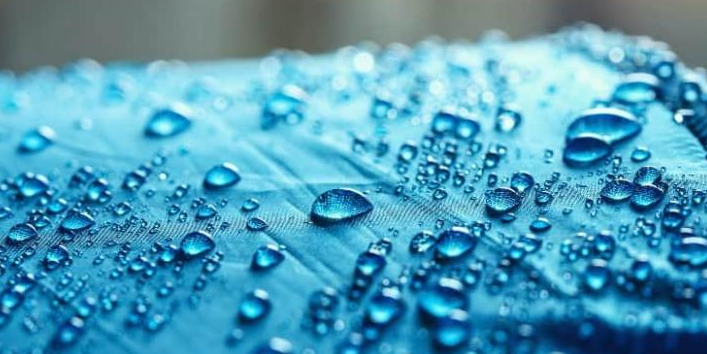
What Is Polyamide Fabric and Why Is It Used in Clothing?
- High tensile strength
- Lightweight yet durable
- Quick-drying
- Flexible and stretchable
- Resistant to wear and abrasion
Is Polyamide Naturally Waterproof?
- Hydrophobic surface helps bead water initially
- Water can seep through seams and gaps in weave
- Prolonged exposure causes absorption
What Makes Polyamide Fabric Waterproof?
- Applied to the surface of polyamide fabrics
- Causes water to bead and roll off
- Common in outdoor garments and Men’s Waterproof Casual Shorts
- DWR wears off over time, especially in washing machines
- Polyurethane (PU) or Thermoplastic Polyurethane (TPU) membranes are bonded to the fabric
- Provides full waterproofing, even under pressure
- Common in rain jackets and waterproof trousers
- High-density weaving reduces gaps between fibers
- Offers inherent water resistance without coating
- Less effective than laminated solutions
Does Washing Affect Polyamide’s Waterproof Properties?
- DWR coatings degrade after several washes
- Harsh detergents strip protective finishes
- Heat from drying can damage membranes
- Abrasion from machine wash weakens waterproofing at seams
- Use mild, non-detergent soap
- Avoid fabric softeners
- Wash on gentle or hand-wash cycles
- Reapply DWR sprays after several washes
- Air dry when possible to protect coatings
Is Polyamide Fabric Waterproof After Repeated Washing?

How to Identify if Your Polyamide Clothing is Waterproof?
- Waterproof Rating (e.g., 5000mm or 10K)
- Sealed or taped seams
- Water-repellent finish (DWR)
- Label or tag information indicating waterproofness
How Does Polyamide Compare to Other Waterproof Fabrics in the Wash?
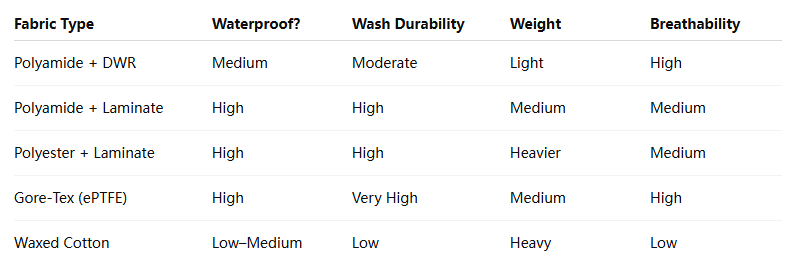
What’s the Best Way to Wash Polyamide Waterproof Garments?
- Temperature: Cold to lukewarm (30°C max)
- Cycle: Delicate or hand-wash
- Detergent: Specialized soap for technical gear
- Drying: Hang dry or tumble on low (check label)
- Ironing: Avoid unless label allows low heat
- Waterproof Reproofing: Apply spray or wash-in DWR every 5–10 washes
Are Polyamide Waterproof Shorts Ideal for Summer and Rainy Seasons?
- Beach activities: Quick-drying, non-absorbent
- Hiking and Camping: Lightweight and water-resistant
- Urban use: Stylish yet functional for sudden rain
- Travel: Packable and easy to clean
How Long Does Waterproof Polyamide Last?
- With Proper Care: 3–5 years of reliable use
- Without Reproofing: 1–2 years before major degradation
- Laminated Fabrics: 5–10 years, depending on usage
Can You Re-Waterproof Polyamide Clothing?
- Best for breathable layers
- Quick application
- Works well on Men’s Waterproof Casual Shorts
- Uniform application
- May affect breathability
- Ideal for outer layers like jackets
Are All Polyamide Garments Waterproof by Default?
- Underwear, base layers: Usually uncoated, breathable only
- Running shorts: Often DWR-coated for light rain protection
- Men’s Waterproof Casual Shorts: Designed with laminated or DWR-treated polyamide for weather defense
Polyamide Fabric Waterproof: Myths vs. Facts
Understanding these differences empowers consumers to make smart wardrobe investments.
Conclusion: Is Polyamide Fabric Waterproof in a Washing Machine?
Understanding Scooty Off Road Suspension Systems

What Makes a Good Suspension for Scooty Off Road?
- Shock Absorption: Effective damping to reduce impact from rough surfaces.
- Travel Distance: Longer suspension travel allows better handling of uneven terrain.
- Adjustability: Adjustable suspensions cater to different rider weights and terrains.
- Durability: High-quality materials ensure longevity under harsh conditions.
Types of Suspension Systems for Scooty Off Road
- Coil Spring Suspension: Common in entry-level scooty off road models, coil springs offer reliable shock absorption but may lack adjustability.
- Air Suspension: Found in premium scooty off road vehicles, air suspensions provide customizable firmness and lightweight construction.
- Hydraulic Suspension: These use fluid-based damping for smooth performance, ideal for rugged terrains.
- Monoshock Suspension: A single rear shock absorber enhances stability and is popular in high-performance scooty off road models.
Top Features to Look for in Scooty Off Road Suspension
Suspension Travel and Ground Clearance
Adjustability and Tuning
Material Quality and Build
Comparing Top Scooty Off Road Models for Suspension
Entry-Level Scooty Off Road Models
- Model A: Features a coil spring front fork with 100mm travel and a rear monoshock. Ideal for light off-road trails, it offers decent shock absorption but limited adjustability. Ground clearance of 8 inches suits moderate terrains.
- Model B: Equipped with hydraulic front forks (90mm travel) and a dual rear shock setup. Its affordability makes it popular for beginners, though it struggles on steep inclines.
Mid-Range Scooty Off Road Options
- Model C: Boasts a 120mm air suspension front fork and adjustable rear monoshock. Its 9-inch ground clearance and tunable damping make it versatile for mixed terrains, from gravel to mud.
- Model D: Features hydraulic suspension with 110mm travel and a robust aluminum frame. Its dual shock rear system enhances stability, ideal for intermediate riders tackling varied off-road conditions.
Premium Scooty Off Road Models
- Model E: A top-tier scooty off road with 150mm air suspension forks and a fully adjustable monoshock. Its 10-inch ground clearance and advanced damping system excel in extreme conditions like rocky trails or steep descents.
- Model F: Features a high-end hydraulic suspension with 140mm travel and electronic tuning. Designed for professional riders, it offers superior shock absorption and precision handling.
Factors Influencing Scooty Off Road Suspension Performance
Rider Weight and Load
Terrain Type
- Rocky Trails: Require long-travel suspensions with strong damping.
- Sandy Dunes: Benefit from softer suspensions for better traction.
- Mud: Needs high ground clearance to avoid bogging down.
Maintenance and Upkeep
- Cleaning forks and shocks to remove dirt and debris.
- Checking for oil leaks or worn seals.
- Adjusting preload and damping based on riding conditions.
How to Test Scooty Off Road Suspension
- Ride on Mixed Terrains: Test the scooty off road on gravel, dirt, and uneven surfaces to assess shock absorption and stability.
- Check Adjustability: Experiment with preload and damping settings to confirm versatility.
- Evaluate Comfort: Ensure the suspension minimizes vibrations and maintains control during sharp turns or jumps.
- Inspect Build Quality: Look for robust materials and smooth operation without creaking or stiffness.
Future Trends in Scooty Off Road Suspension Technology
- Smart Suspensions: Emerging scooty off road models incorporate sensors to adjust damping automatically based on terrain, improving ride quality.
- Lightweight Materials: Carbon fiber and advanced alloys reduce weight without sacrificing strength, enhancing agility.
- Eco-Friendly Designs: Electric scooty off road models, like those meeting ROHS and EEC certifications, integrate efficient suspensions with sustainable powertrains.
Conclusion
Why Is the Scooter Weight Limit Important?
- Structural safety: Prevents frame deformation or cracking
- Motor performance: Ensures optimal acceleration and climbing ability
- Battery range: Heavier loads reduce efficiency
- Braking system: Avoids brake strain or failure
- Tire wear and durability: Proper load avoids premature tire wear

What Determines the Weight Capacity of a Scooter?
a. Frame Material
- Aluminum Alloy: Common, lightweight, moderate capacity (up to 220 lbs / 100 kg)
- Steel: Stronger, heavier, often supports up to 265 lbs (120 kg)
- Carbon Fiber: Lightweight and strong, seen in premium models
b. Motor Power
- Scooters with 250W motors typically support up to 100 kg
- 500W – 1000W motors handle heavier riders up to 120–150 kg
- Dual motor scooters (2000W+ combined) support 150 kg and more
c. Suspension and Tires
- Large pneumatic tires and reinforced suspension systems support greater loads
- Solid tires generally support less weight than air-filled tires
d. Deck Size and Reinforcement
- A longer, reinforced deck improves rider stability and load support
- Deck thickness and subframe bracing matter
e. Braking System
- Stronger brakes (hydraulic or disc) are essential for heavier loads
What Are the Typical Scooter Weight Limits by Type?
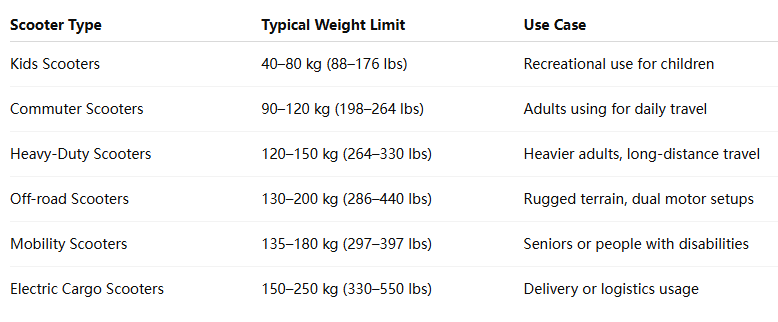
What Happens If You Exceed the Scooter Weight Limit?
- Reduced Speed and Acceleration: Overload strains the motor
- Shortened Battery Life: Higher current draw due to load
- Frame or Fork Bending: Over time, aluminum or alloy frames may warp
- Flat Tires or Rim Damage: Especially with underinflated air tires
- Brake Overheating or Failure: Brakes may become less responsive under excess weight
How to Choose the Right Scooter Based on Rider Weight?

How Does the Scooter Weight Limit Affect Performance?
Heavier riders require more power to achieve the same speed. Underpowered scooters may feel sluggish if the rider is close to or over the limit.
Low-watt scooters under 300W struggle on inclines with heavier loads. Choose 500W+ for hills if you weigh over 90 kg.
The heavier the rider, the more energy the motor consumes. Expect 10–30% reduced range near max weight limits.
Heavier loads increase stopping distance. This requires more powerful braking systems (e.g., hydraulic vs. drum).
Are There Scooters for Overweight or Heavier Riders?
- Riders over 120 kg
- Cargo and delivery purposes
- Off-road exploration
- Dual motors (500W–1000W each)
- Wide decks
- Large 10–11 inch tires
- Dual suspension
- Scooter weight limits of 150–200+ kg
How Does Rider Behavior Impact Scooter Load Handling?
- Sudden braking or aggressive acceleration increases stress
- Jumping curbs or uneven terrain riding may lead to frame cracks
- Improper tire inflation worsens wear under heavier riders
- Incorrect posture (leaning back excessively) may cause instability
Are There Standards or Certifications for Scooter Weight Limits?
- ISO 7176 (mobility scooters)
- EN 17128 (electrically powered personal transporters)
- UL 2272 (battery and fire safety)
What Should You Consider If You Carry Cargo or Passengers?
- A backpack or shopping bag
- Child seat attachment
- Delivery boxes
How to Maintain a Scooter Near Its Weight Limit?
- Check tire pressure weekly (especially for pneumatic tires)
- Lubricate moving parts regularly
- Inspect deck and stem bolts monthly
- Monitor brake performance frequently
- Charge battery correctly and avoid deep discharges
Can You Increase a Scooter’s Weight Limit?
- Aftermarket suspension upgrades
- Stronger tires
- Battery replacements with higher output
Final Thoughts: What Scooter Weight Limit Should You Aim For?
- Choose one with 20–30 kg more than your body + cargo
- Review real-world tests and reviews, not just spec sheets
- Prioritize safety and structural integrity over speed or design
- Understand that higher weight limit = higher cost and weight of scooter itself
Conclusion: Understanding and Respecting the Scooter Weight Limit Ensures Safety and Longevity
Introduction to CO2 Liquefaction
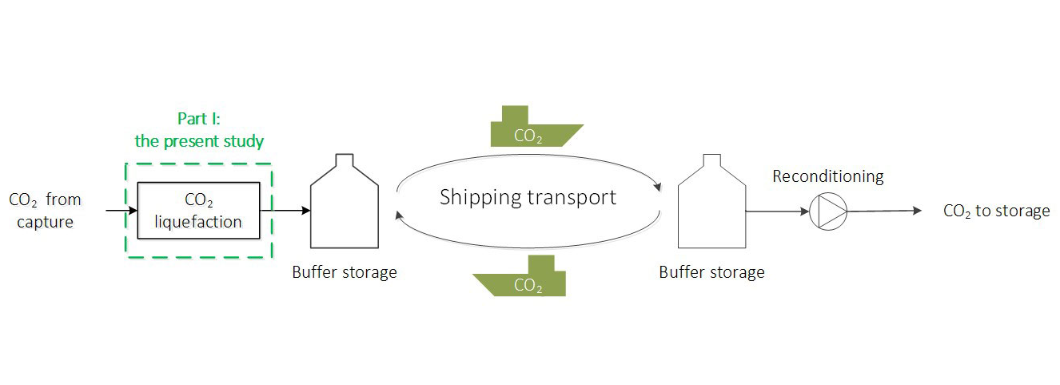
Why CO2 Liquefaction Matters
Factors Influencing CO2 Liquefaction Plant Costs
Capital Investment (CapEx)
- Equipment Costs: Major components include compressors, heat exchangers, and refrigeration systems. For instance, a CO2 compressor and ammonia-based refrigeration circuit are critical for liquefaction. Companies like Hangzhou Z-Oxygen Intelligent Device Co., Ltd. provide advanced solutions for such systems.
- Engineering and Design: Customized designs for specific feed gas compositions or applications, such as integration with an Airgas Microbulk Tank for LO2 LN2 LAr LNG and LCO2, can increase costs due to specialized engineering.
- Installation and Infrastructure: Site preparation, piping, and storage tanks add to the initial investment. Modular plants, which offer pre-tested components, can reduce installation costs by up to 20%.
Operational Costs (OpEx)
- Energy Consumption: CO2 liquefaction is energy-intensive, requiring approximately 100 kWh per ton of CO2 liquefied, translating to a cost of $10–$20 per ton at average electricity rates of $0.10–$0.20 per kWh. Energy-efficient designs, such as those using advanced cryogenic systems, can lower these costs.
- Maintenance: Regular maintenance of compressors, dryers, and adsorbers ensures operational efficiency. Annual maintenance costs typically range from 2–5% of the initial capital investment.
- Labor: Operating a CO2 liquefaction plant requires skilled technicians and operators. Labor costs vary by region but can account for 10–20% of operational expenses.
Feedstock and Raw Material Costs
Location and Regulatory Factors
CO2 Liquefaction Process and Technology
How CO2 Liquefaction Works
Technological Innovations
- Modular Designs: Standardized, modular plants reduce engineering and installation costs while maintaining flexibility for varying feed gas compositions.
- Energy Optimization: Integrating CO2 liquefaction with renewable energy sources or waste heat recovery systems can lower energy costs by 10–15%.
- Alternative Technologies: Membrane-based separation is emerging as a lower-cost alternative to cryogenic methods, though it is less common for high-purity applications.
Cost Estimates for CO2 Liquefaction Plants in 2025
- Small-Scale Plants (100–500 TPD): Capital costs range from $5 million to $15 million, with operational costs of $20–$40 per ton of CO2. These plants are suitable for localized applications like beverage carbonation.
- Medium-Scale Plants (500–2,000 TPD): Capital costs range from $15 million to $30 million, with operational costs of $15–$30 per ton. These are common in industrial hubs with access to CO2-rich feedstocks.
- Large-Scale Plants (>2,000 TPD): Capital costs can exceed $50 million, with operational costs as low as $10–$20 per ton due to economies of scale. These plants are often integrated with CCS projects.
Price Trends for Liquid CO2
Economic Viability and ROI Considerations
Strategies to Reduce Costs
- Leverage Byproduct CO2: Sourcing CO2 from high-purity streams, such as ethanol plants, reduces purification costs.
- Adopt Modular Systems: Modular plants lower upfront costs and accelerate deployment.
- Integrate Renewables: Using renewable energy for compression and cooling can reduce operational expenses.
- Optimize Scale: Larger plants benefit from economies of scale, reducing per-ton costs.
Applications of Liquid CO2
- Food and Beverage: Used for carbonation and food preservation, accounting for over 50% of global demand.
- Industrial Uses: Employed in welding, chemical synthesis, and enhanced oil recovery.
- Healthcare: Used in cryotherapy and pharmaceutical extraction processes.
- Carbon Capture and Storage: Liquefied CO2 is transported and stored to reduce greenhouse gas emissions.
Challenges and Future Outlook
Conclusion

What Is a Gas Purifier?
Where Gas Purifiers Fit in Air Separation Systems
- Cryogenic distillation, where air is liquefied and separated based on boiling points.
- Pressure Swing Adsorption (PSA), which uses molecular sieves to selectively adsorb gases at different pressures.
- Water vapor doesn’t freeze in cryogenic equipment.
- CO₂ and hydrocarbons don’t block valves or poison catalysts.
- Adsorbents in PSA systems remain active and efficient.
- The final gas meets industrial or medical purity standards.
Common Gas Purification Technologies
Molecular sieves, activated alumina, or silica gel adsorb contaminants such as H₂O and CO₂. These materials physically trap unwanted molecules within their porous structures.
Catalysts convert harmful gases (e.g., hydrocarbons or CO) into benign substances like CO₂ and H₂O using heat or oxygen.
In cryogenic systems, some impurities naturally freeze out due to extremely low temperatures.
Reactive metals or chemical agents bind impurities chemically. Used in ultra-high purity (UHP) gas production for semiconductors.
Compressed Air Purification: First Line of Defense
- Pre-filters for solid particles
- Coalescing filters for oil and water
- Refrigerated or desiccant air dryers
- Activated carbon beds for odor and hydrocarbon removal
Applications Across Industries
Medical oxygen must be free of carbon monoxide, hydrocarbons, and pathogens. A gas purifier ensures patient safety and meets ISO or CE requirements.
In semiconductor manufacturing, ultra-high purity nitrogen, argon, and hydrogen are required. Even trace contamination can ruin a wafer. Gas purifiers in cleanrooms use getter materials and catalytic conversion to reach 99.999999% purity.
Nitrogen and CO₂ are used for packaging, carbonation, and preservation. Odors, oil, or moisture affect taste and shelf life. Food-grade gas purifiers are widely used here.
Shielding gases like argon and nitrogen must be moisture-free and oxygen-free. Inconsistent gas purity affects welding quality, oxidation, and heat treatment.
Analytical instruments like gas chromatographs need clean carrier gases. A gas purifier ensures that test results remain consistent and accurate.
Why Gas Purifiers Fail Without Maintenance
- Changing filters or adsorbents
- Regenerating molecular sieves
- Monitoring pressure drop or breakthrough curves
- Checking seals for leaks
About Hangzhou Z-Oxygen Intelligent Device Co., Ltd.
- PSA Oxygen & Nitrogen Generators
- Cryogenic LO₂ / LN₂ / LAR Storage Tanks
- VPSA Oxygen Generators
- LNG Vaporizing and Filling Stations
- Small Liquid Nitrogen Generators
- Air Boosters and Cryogenic Liquid Pumps
- Gas Purifiers and Purification Skids
- Russia – Cryogenic Air Separation Plants
- Turkey – Liquid Oxygen Storage and Gas Stations
- Thailand – PSA Nitrogen Generator Systems
- South Africa – Oil-Free Compressors with Gas Purification
- Chile – Container-Based Oxygen Generators
Selecting the Right Gas Purifier: Key Considerations
- Gas Type & Application (oxygen, nitrogen, argon, hydrogen, CO₂)
- Required Purity Level (medical, industrial, UHP)
- Contaminants to Remove (moisture, hydrocarbons, dust, oil)
- Flow Rate & System Size
- Integration Requirements (skid-mounted, in-line, panel-type)
- Regulatory Compliance (ISO, CE, FDA, etc.)
Future Trends in Gas Purification
- Smart Gas Purifiers with AI-driven diagnostics
- Modular Purification Skids for mobile or container systems
- Nano-structured Adsorbents offering higher capacity
- Hybrid Filtration Systems combining adsorption, membrane, and catalytic technologies
Conclusion
Introduction to Non-Wetting in Soldering
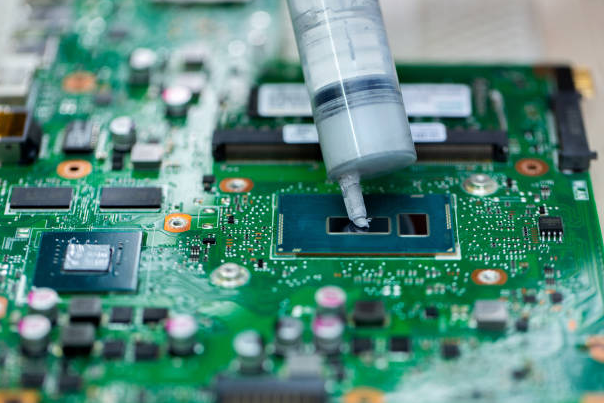
What Causes Non-Wetting in Soldering?
Surface Contamination
Improper Flux Application
Material Incompatibility
Inadequate Heating
Impacts of Non-Wetting in Soldering
Reduced Joint Reliability
Increased Void Formation
Higher Production Costs
Solutions to Prevent Non-Wetting in Soldering
Surface Preparation and Cleaning
Optimizing Flux Selection and Application
Advanced Soldering Technologies
Controlling Soldering Parameters
Role of Vacuum Soldering in Addressing Non-Wetting
Benefits of Vacuum Soldering Systems
Applications in Power Electronics
Formic Acid for Enhanced Wetting
Best Practices for Minimizing Non-Wetting in Soldering
Process Optimization
Training and Quality Assurance
Material Selection
Future Trends in Soldering Technology
Advancements in Vacuum Soldering
Integration with Automation
Eco-Friendly Soldering Solutions
Conclusion
What Is Selective Wave Soldering and Why Is It Used?
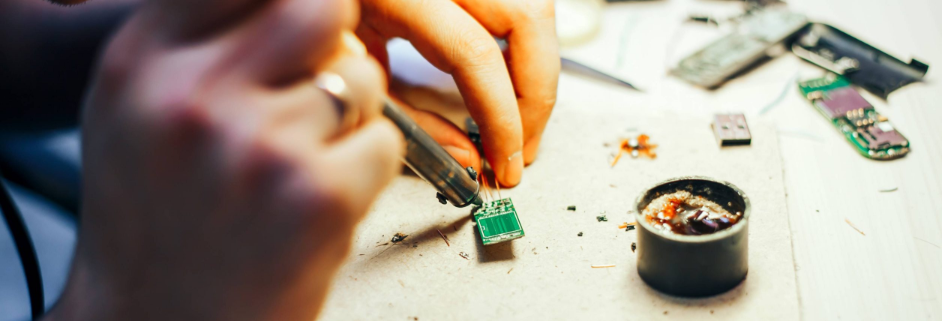
- Reduces thermal stress on components
- Minimizes solder bridges and defects
- Enhances process control and repeatability
- Suitable for high-mix low-volume production
Why Is Oxidation a Problem in Selective Wave Soldering?
- Poor wetting
- Increased solder defects (e.g., non-wetting, dewetting)
- Weakened mechanical joints
- Higher rework rates and reduced production yield
Which Gas Is Commonly Used to Prevent Oxidation in Selective Wave Soldering?
Nitrogen is the most widely used inert gas in selective wave soldering. Here's why:
- Inert Atmosphere: Displaces oxygen around the solder nozzle
- Stable Solder Temperature: Improves wetting behavior
- Flux Efficiency: Reduces flux oxidation and preserves activity
- Solder Joint Quality: Produces cleaner and stronger joints
- Process Consistency: Enables repeatable and reliable results
Flow Rate: 10–25 L/min per nozzle (varies by equipment)
How Is Nitrogen Applied in the Selective Wave Process?
- Nozzle Shrouding: Nitrogen surrounds the mini-wave nozzle directly.
- Preheating Chamber Atmosphere: Reduces early-stage oxidation.
- Enclosed Mini Wave Module: Maintains controlled environment throughout the soldering zone.
What Are the Alternatives to Nitrogen in Selective Soldering?
Formic Acid (HCOOH)
- Effective in oxide removal
- Ideal for fluxless vacuum soldering
- Requires sealed systems
- Strict safety and exhaust controls needed
What Role Does Nitrogen Play in Advanced Vacuum Soldering Equipment?
Vacuum Reflow Soldering Oven
- Eliminate voids in solder joints
- Enable fluxless or low-residue soldering
- Support applications like IGBT, MOSFET, and diode packaging
Inline Nitrogen Vacuum Soldering Oven
- High yield and throughput
- Consistent solder joint quality
- Suitability for leadframe or ceramic substrates
How Does Using Nitrogen Improve Quality and Reliability in Selective Wave Soldering?
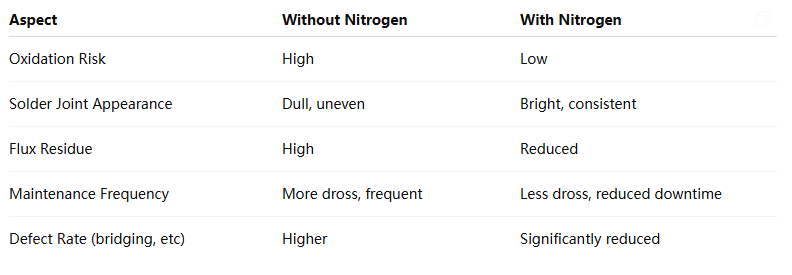
Are There Challenges in Using Nitrogen in Selective Soldering?
- Cost of Nitrogen Supply: Especially in facilities without central gas delivery systems.
- System Compatibility: Not all older soldering machines support nitrogen integration.
- Process Balancing: Incorrect flow can cool the solder or displace flux.
Can Nitrogen Use Be Optimized to Reduce Costs?
- Use On-site Nitrogen Generators: PSA systems to reduce bottled gas cost
- Smart Gas Flow Control: Adjusting based on PCB complexity and dwell time
- Zonal Application: Targeted delivery around solder nozzle instead of entire chamber
- Scheduled Maintenance: Prevents leaks and ensures efficient gas use
What Industries Benefit Most from Nitrogen-Based Selective Soldering?
- Automotive Electronics (ECUs, sensors, BMS modules)
- Power Semiconductors (e.g., IGBT, SiC devices)
- Medical Devices (implantables, imaging PCBs)
- Telecom and Networking Equipment
- Aerospace and Military Hardware
Conclusion: Why Nitrogen Is the Gas of Choice in Selective Wave Soldering
Introduction

What Happens When Dressings Stick to a Wound?
· Tear off newly formed tissue
These outcomes are not only detrimental to the healing process but also increase healthcare costs and resource use due to prolonged treatment durations.
What Is a Wound Edge Protector?
Key functions of a wound edge protector include:
· Maintaining the integrity of the wound edge
Why Do Wound Dressings Stick?
1. Inappropriate Dressing Type
Traditional dressings like cotton gauze can easily absorb fluids and dry out, sticking to the wound. Non-adherent dressings or dressings with a silicone interface are designed to prevent this.
2. Insufficient Moisture
A moist wound environment is crucial for healing. When wounds dry out, dressings are more likely to adhere. Moisture-retaining dressings like hydrogels or hydrocolloids help maintain the ideal balance.
3. Lack of Wound Edge Protection
Without a wound edge protector, dressing removal can inadvertently damage the skin at the edge of the wound, causing further trauma.
4. Improper Dressing Technique
Incorrect dressing application, including overtight wrapping or inadequate padding, can cause pressure and sticking.
Preparing the Wound for Coverage
1. Clean the Wound
Use sterile saline or prescribed antiseptic solutions to cleanse the wound gently. Avoid harsh chemicals like hydrogen peroxide unless directed by a healthcare provider.
2. Dry the Surrounding Skin
Blot the skin around the wound dry with sterile gauze to help dressing adhesives stick to healthy skin rather than the wound bed.
3. Apply a Moisture Barrier
Ointments such as petroleum jelly or specially formulated wound gels can create a protective layer that prevents sticking and keeps the wound moist.
4. Position the Wound Edge Protector
If available, place a wound edge protector around the wound to isolate the edge and prevent adhesion during dressing placement.
Choosing the Right Dressing Materials
Non-Adherent Dressings
These are designed not to stick to wounds and include materials like Telfa pads or Adaptic.
Silicone Dressings
These dressings use a soft silicone layer that gently adheres to surrounding skin but not to the wound bed. They are especially helpful for sensitive skin or frequent dressing changes.
Hydrogel Dressings
Hydrogels maintain a moist environment and are ideal for dry or necrotic wounds.
Hydrocolloid Dressings
These form a gel upon contact with wound exudate and are excellent for maintaining moisture while preventing sticking.
Foam Dressings
Foam offers high absorbency and cushioning. Some foams come with a silicone contact layer, combining comfort with non-adherence.
Film Dressings
Thin, transparent, and breathable, film dressings are good for low-exudate wounds but may require caution to avoid sticking in dry conditions.
Using a Wound Edge Protector in Surgical Settings
· Keep the surgical site open and accessible
Studies have shown that the use of wound edge protectors in abdominal surgeries, especially colorectal procedures, can reduce the SSI rate by up to 50%.
Home Use of Wound Edge Protectors
· Diabetic foot ulcers
When using a wound edge protector at home:
· Ensure it is sterile and single-use unless otherwise directed
Removing Dressings Safely
· Moisten the dressing with sterile saline if it's dry or stuck
Maintaining Wound Hygiene
· Clean the wound daily or as advised
When to Consult a Professional
· Persistent or increasing pain
Do not attempt advanced care, including the use of wound edge protectors, without guidance if unsure.
Advances in Wound Edge Protector Design
· Dual-ring designs for secure placement
These improvements enhance not only safety and hygiene but also make the devices easier to use in various settings.
Professional Recommendations for Wound Edge Protector Use
· General and colorectal surgeries
Products from globally recognized companies such as Kangji Medical are widely trusted by surgical teams for their precision design, biocompatibility, and quality assurance.
Common Myths About Wound Dressing and Protection
· Myth: "Letting the wound dry out helps it heal faster."
· Myth: "All dressings prevent sticking."
· Myth: "Wound edge protectors are only for hospitals."
Summary: Best Practices for Non-Stick Wound Dressing
Final Thoughts
Whether in a hospital setting or at home, the use of wound edge protectors represents a significant advancement in wound management. As technology and awareness improve, these tools will become a standard in both professional and personal care environments.
Why Fabric Choice Matters for High End Medical Scrubs

Comfort and Breathability
Durability and Maintenance
Functionality and Professionalism
Top Fabrics for High End Medical Scrubs
Cotton: The Classic Choice
Polyester: Durability and Low Maintenance
Cotton-Polyester Blends: The Best of Both Worlds
Spandex Blends: Flexibility and Fit
Rayon: Softness and Drape
Bamboo: Eco-Friendly and Antimicrobial
Key Features to Look for in High End Medical Scrubs Fabrics
Antimicrobial Properties
Moisture-Wicking Technology
Stain and Fluid Resistance
Stretch and Flexibility
Choosing the Right Fabric for Your Role
Care and Maintenance of High End Medical Scrubs
Trends in High End Medical Scrubs Fabrics
Conclusion
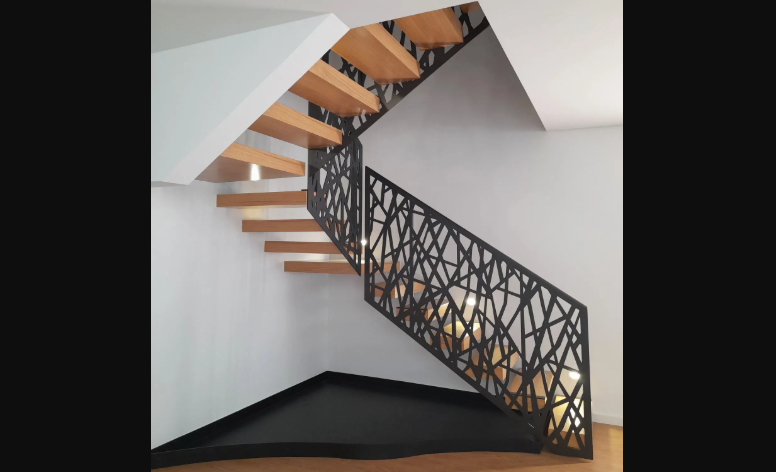
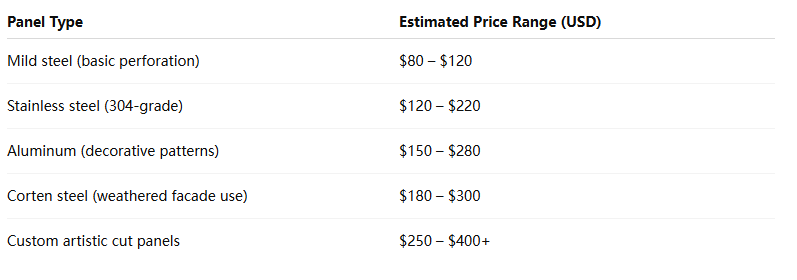
What Key Factors Influence Laser Cut Staircase Panels Cost?
Material Selection
- Mild Steel: The most affordable option, suitable for industrial environments.
- Stainless Steel: Offers corrosion resistance and is ideal for indoor and outdoor architectural designs.
- Aluminum: Lightweight, rust-resistant, and slightly more expensive due to raw material costs.
- Corten Steel: Preferred for weathered outdoor designs, higher in price.
- Galvanized Steel: Provides rust resistance at a lower cost than stainless steel.
Panel Size and Thickness
- More cutting time
- Higher energy consumption
- Increased raw material usage
- Additional support for transportation or installation
- A 3mm thick panel might cost 20–30% less than a 6mm thick panel of the same material and design.
Design Complexity
- Artistic patterns with curves, tight tolerances, or layered detailing require extensive CNC programming and longer cutting times.
- High-resolution designs also create more waste, which adds to material cost.
Type of Finish
- Raw steel: No additional cost but prone to rust.
- Powder coating: Durable, weather-resistant, available in custom colors.
- Anodizing (for aluminum): Offers protection and color options.
- Painted finishes: Lower durability than powder coating, but lower cost.
- Brushed/polished stainless steel: For high-end interior applications.
Quantity Ordered
- Setup costs (machine programming, tooling) are distributed over more units.
- Bulk raw material purchases lower per-panel material cost.
- Freight per panel drops when shipped in bulk.
Shipping and Location
- Panel size and weight
- Destination country
- Urgency (air vs. sea freight)
How Do Applications Impact Laser Cut Staircase Panels Cost?
Industrial Applications
- Walkways
- Safety barriers
- Stair treads and platforms
Architectural Applications
- Stair railings
- Balustrades
- Decorative partitions
Global Pricing Trends for Laser Cut Staircase Panels Cost
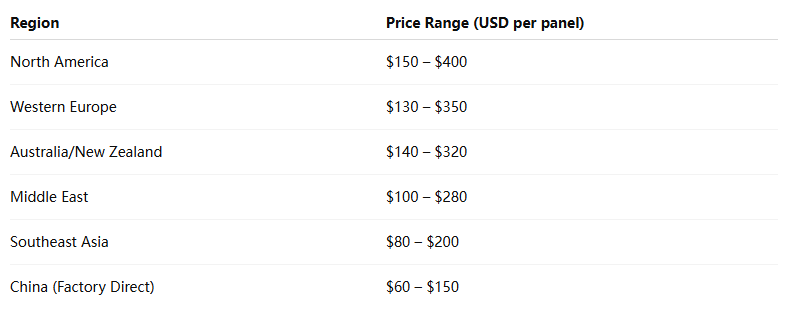
How to Calculate Total Laser Cut Staircase Panels Cost for a Project?
- Panel cost per unit × Quantity
- Design fee or setup cost (often $100–$300 for custom work)
- Shipping charges
- Customs/duties
- Installation and fitting
- Accessories and hardware
- You are installing 12 aluminum staircase panels for a residential project.
- Panel cost: $180 × 12 = $2,160
- Design setup: $200
- Powder coating: $50 × 12 = $600
- Shipping & duty: $350
- Total ≈ $3,310
What Mistakes to Avoid When Estimating Laser Cut Staircase Panels Cost?
Ignoring Setup Fees
Underestimating Shipping Costs
Overlooking Installation Complexity
Forgetting Compliance Requirements
How to Reduce Laser Cut Staircase Panels Cost Effectively?
Use Pre-Designed Patterns
Stick to Standard Sizes
Choose Efficient Materials
Buy in Bulk
Compare Local and Overseas Options
What to Ask Suppliers When Quoting Laser Cut Staircase Panels Cost?
- Is the panel cost all-inclusive (material, cutting, finishing)?
- Are there extra charges for design or customization?
- Can you provide installation drawings or mounting suggestions?
- What is the estimated lead time and delivery method?
- Is the finish weather-resistant or suitable for indoor use?
- Are there volume discounts?
Conclusion: What Should You Expect When Planning for Laser Cut Staircase Panels Cost?
Advantages of Perforated Metal Architecture in Metal Buildings
Exceptional Durability and Strength
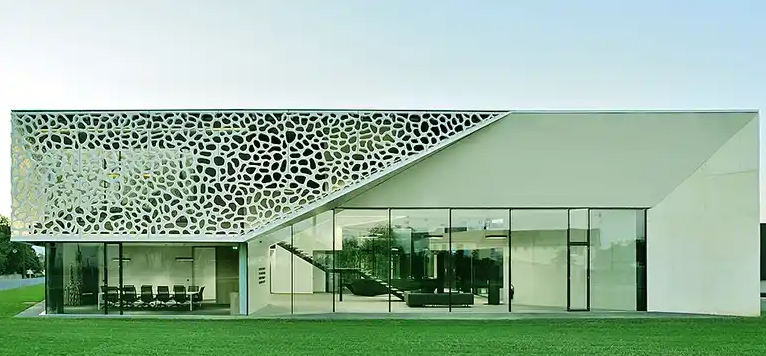
Aesthetic Versatility
Enhanced Ventilation and Light Control
Sustainability and Recyclability
Low Maintenance Requirements
Disadvantages of Perforated Metal Architecture in Metal Buildings
High Initial Costs
Limited Insulation Properties
Potential for Corrosion in Certain Environments
Acoustic Challenges
Design and Fabrication Complexity
Applications of Perforated Metal Architecture
Industrial Applications
Architectural Applications
Key Considerations for Implementing Perforated Metal Architecture
Material Selection
Customization and Design
Cost-Benefit Analysis
Conclusion
The Psalmist tells us that our days are numbered. Since we don't know how God determines the number of days we have, the Psalmist vowed to watch what he does and not sin in what he says.
Click on the link below to see what the New Testament says about that subject. #BibleStudy #Devotions #EndTimes #Psalms #worship
